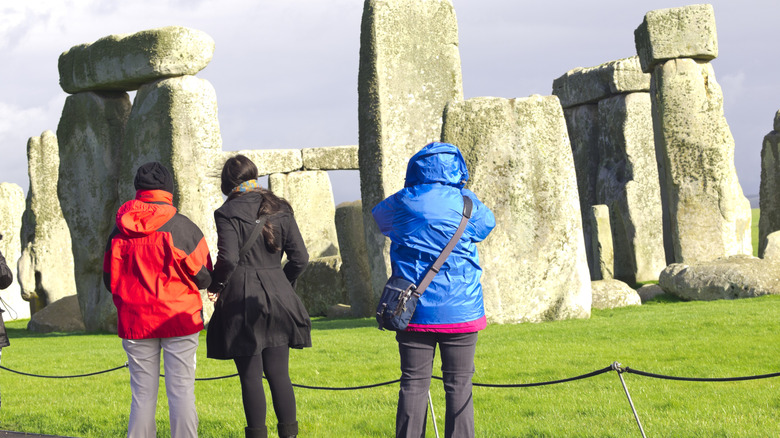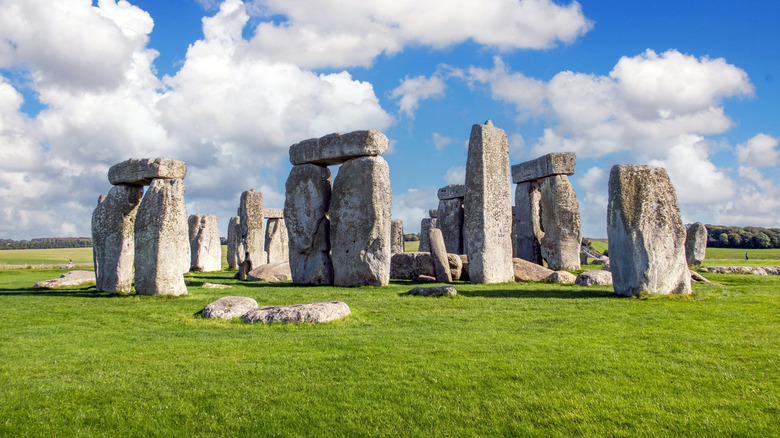One Of The World's Most Disappointing Attractions Is An Underwhelming Monument Shrouded In Mystery
Travelers come all the way out into a remote field in England — more than two hours from London, and for a hefty admission price, no less — to see the famed monument of Stonehenge. Perhaps they imagine druids, battles, or baffling Neolithic rituals, only to find the ancient scene tainted by a backdrop of congested roads and roped-off stones that prevent them from touching or even walking among them. Add the fact that the stones might be smaller than expected after years of built-up anticipation, and it's easy to see why Stonehenge has earned a reputation as one of the most disappointing tourist attractions in the world.
Some of the elements that take away from Stonehenge's awe weren't always like that, though. There used to be no rope, no restrictions against climbing the stones, and people often picnicked and gathered at the monument for celebrations. In the 19th century, visitors were even given chisels to break off a piece to take home. Today, visitors are kept in check with timed tickets, a shuttle bus or a 25- to 40-minute walk to the stones, and rope barriers. These formalities are in place for good reason — with over 9,000 visitors in a day during peak season, the wear and tear on the site would be devastating without them. And if you move past the initial disappointment, you can still marvel at a site that, despite the modern world rising around it, remains an ancient mystery.
Why Stonehenge might not live up to the hype
Almost everyone hears about Stonehenge to such an extent that the mythos built around the monument can make seeing the stones in person feel pretty lackluster. One visitor wrote on TripAdvisor, "Just a load of rocks lying about, willy-nilly. They're not even that big really: was expecting bigger." For many visitors, one of the first impressions Stonehenge leaves is that the stones are smaller than expected. Surrounded by an empty field and viewed from a roped-off distance, it's natural that the real-life size doesn't compare to the close-up photographs or drone footage that primed you. It's worth keeping in mind, though, that the scale of effort, rather than the size, is what makes the monument one of the most mysterious places around the globe. The stones, weighing around 25 tons each, were dragged nearly 20 miles to the site around 4,600 years ago and required an estimated 20 million hours to build.
A big contributor to Stonehenge's reputation for disappointment is the price. You can expect to pay around £30 (roughly $40) for a standard timed ticket, plus an additional parking charge. Many argue that the cost isn't worth it, especially when you're shuffled along with large crowds and don't even get to enter the stone circle. What you might not know, though, is that it's possible (and legal) to visit for free. A public walking path next to the ticketed entrance offers great views of the monument. From this path, you get to see Stonehenge from about the same distance as the paid path — the only difference is that tickets allow you to walk the perimeter of the stone circle, while the free path only passes along one side.
Tips for making the most of Stonehenge
Before you head out to the stone circle itself, it's worth stopping at the visitor center, where you can take some time to learn about its history and context. The visitor center features artifacts from the Bronze Age, a virtual exhibition that gives you a perspective from within the stone circle, and recreated Neolithic huts. Then, if you're able, consider taking the scenic walk from the visitor center to the stones rather than taking the shuttle. Not only does this give you some time to shift out of your everyday mindset before stepping into the sacred ground, but it also lets you see some Bronze Age burial mounds along the way.
Timing is another thing to factor if you want to avoid crowds. Peak season runs from April through September, so you can minimize crowds by coming outside these months. If you're booking a ticket, try for the earliest or latest available times. Those sticking to the free footpath can visit outside ticketed hours and encounter even fewer people.
To get to Stonehenge, you can reach the nearby town of Salisbury from London in about 1.5 hours by train. From the Salisbury train station, it's about a 20-minute drive or a 30-minute bus ride to the Stonehenge visitor center. Of course, if you ultimately think a visit to Stonehenge isn't worth the trip, consider heading instead to the Avebury World Heritage Site, a charming village with its own Neolithic monument.


